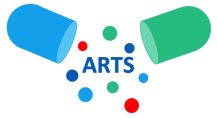‘General practitioners are specialists trained in the principles of the discipline. They are personal doctors, primarily responsible for the provision of comprehensive and continuing care to every individual seeking medical care irrespective of age, sex and illness. They care for individuals in the context of their family, their community, and their culture, always respecting the autonomy of their patients. They recognise they will also have a professional responsibility to their community. In negotiating management plans with their patients, they integrate physical, psychological, social, cultural and existential factors, utilising the knowledge and trust engendered by repeated contacts. General practitioners exercise their professional role by promoting health, preventing disease and providing cure, care, or palliation. This is done either directly or through the services of others according to health needs and the resources available within the community they serve, assisting patients where necessary in accessing these services. They must take the responsibility for developing and maintaining their skills, personal balance and values as a basis for effective and safe patient care.’
The European definition of General Practice, Wonca Europe 2005
Visit any bookshop and you will struggle to find more than a handful of books on General Practice. Maybe this is because GPs recognise that the skills, knowledge and attitudes required to be a GP are learnt from seeing patients and not from text books. The tools of a GP’s trade are ‘consultation skills’, the acquisition of which is the focus of GP Training. GPs are also required to have an understanding of the context in which they work and a good knowledge of medical conditions.
If I owned a bookshop, these are the books that would be on the ‘General Practice’ shelf:
general practice
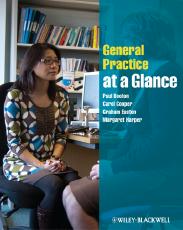
This book provides an overview of what General Practice is all about.
medical knowledge
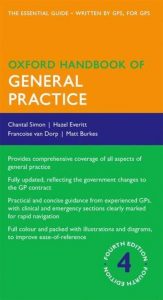
This fits in your doctors’ bag, and if the there is no internet access it’s a very helpful reference book for common medical conditions. Web based resources such as ‘GP Notebook’ offer a more up to date and extensive source of information.
GP training
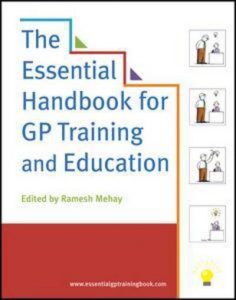
This book is the best resource for all GP trainees and their trainers. The editor Ramesh Mehay has set up an excellent website, www.theessentialgptrainingbookto support and complement the resources in this book.
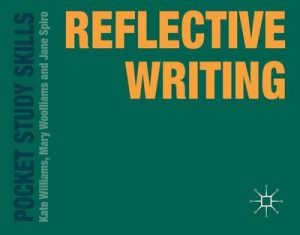
This little book offers some great guidance about reflective writing. It would really help GP Trainees with their learning log entries in their e-portfolio.
consultation skills
There are many of books written on consultation skills. I have chosen to list these books in the order in which they were first published. Each author offers their own perspective on the consultation and all are a valuable contribution to the development of consultation skills in General Practice.
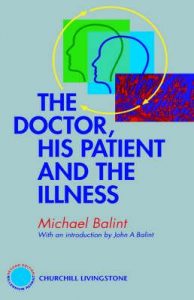
The Doctor, his Patient and the Illness Michael Balint (First published 1957 current edition 1964 Churchill Livingstone)
Balint, a psychoanalyst worked with groups of GPs in London to explore the doctor- patient relationship and develop a better understanding of the psychological aspects of the consultation. He highlighted the importance of the doctor listening to a patient and not just asking questions. His book outlines many case studies and is an informative and easy-to-read book. Most doctors will have come across Balint Groups and may have participated in one during their training. The aim of the groupsfollows Balint’s work in exploiting the psychological aspects of the interaction between patient and doctor.
Doctors Talking to Patients Patrick Byrne and Barry Long (First Published 1976 by Her Majesty’s Stationary Office)
I can’t imagine that many current trainees have picked up this book and read it, but it is an important historical record of GP consultations in the 1970s and a milestone in the development of consultation skills in General Practice. The book evolved from the analysis of taped audio consultations between GPs and their patients in Manchester. The authors discovered that many patients were disappointed with the outcome of their consultation because the doctor had not discovered why they had attended. The authors aim was to improve GPs consultation skills by introducing them to ideas derived from counselling and teacher training.
Disease versus illness in general practice. Hellman. J Royal College of General Practitioners. 1981
Hellman, a medical anthropologist used this article to outline his ‘patient- centred’ model of care, which he called ‘the folk model’. The model is based around 6 questions. The questions are a very useful tool to use when undertaking consultation analysis.
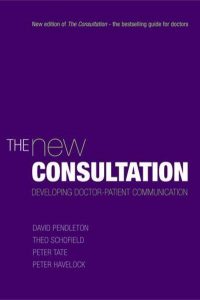
The Consultation David Pendleton, Schofield, Tate and Haverlock (First Published 1984, current edition published as The New Consultation 2003 Oxford University Press)
This book builds on the research by Byrne and Long and discusses the importance of the patient’s role in the consultation. It highlights the need for the doctor to understand the patient’s problem from the patient’s perspective. This book introduces concepts on which the ‘ICE’ model (ideas, concerns and expectations) is based.
In his foreword, Dr John Horder quotes Sir James Spence, ‘before explanation and advice can be given to the patient, three diagnoses must be made – the diagnosis of the disease, of the concept or fears of the disease in the mind of the patient, and of the patient’s capacity to understand the explanation.’
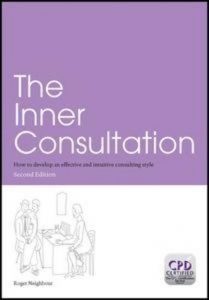
The Inner Consultation Roger Neighbour (First published 1987 current edition 2015 CRC Press)
Neighbour, a GP and Trainer treats the consultation as a journey that passes through five easy to remember checkpoints: connecting, summarising, handing over, safety netting and housekeeping. His book is divided into three sections; the first explores his consultation model, the second uses a colourful range of resources to help the leaner develop their skills and the third looks at strategies for refining the consultation. The book closes with a narrative about ‘the art of the consultation’, and a quote, ‘it is one of the most beautiful compensations of this life, that no man can sincerely try to help another without helping himself.’
Neighbour has written two other books that aim to develop consultation skills, ‘The Inner Apprentice’ and ‘The Inner Physician’. He also shares his knowledge and expertise in seminars and consultation skills courses.
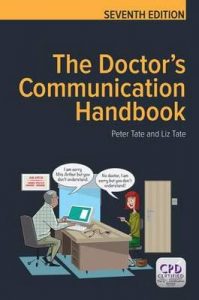
The Doctors Communication Handbook Peter Tate (First Published 1994 current edition 2014 CRC Press)
This is gentle and easy to read book about ‘the consultation’. It gives clear helpful advice and examples of how to improve.
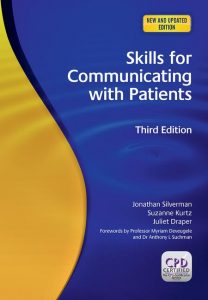 Skills for Communicating with Patients Johnathon Silverman, Suzanne Kurtz and Juliet Draper (First published 1998 Current edition 2013 CRC Press)
Skills for Communicating with Patients Johnathon Silverman, Suzanne Kurtz and Juliet Draper (First published 1998 Current edition 2013 CRC Press)
This book describes an evidence-based, practical consultation framework on which many medical schools have based their communication skills training. The framework is known as the Calgary -Cambridge model because of where the authors work; Silverman at the University of Cambridge and Kurtz at the University of Calgary. It is also built around a five-point model: initiating the session, gathering information, building the relationship, explanation and planning, closing the session.
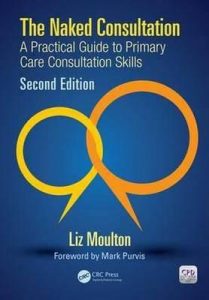
The Naked Consultation Liz Moulton (First published 2007 current edition 2015 Taylor and Francis Ltd)
This is a great book for any GP who wants to develop their consultation skills. It is up to date, well laid out, easy to read, covers all the common consultation models and helps learners put new skills into practice.
Roger Neighbour says of the book, it ‘is exactly what it says on the tin: ‘a practical guide to consultation skills for any health professional working in primary care.’
For something slightly different take a look at an article called ‘the consultation hill’ it uses the analogy of climbing a mountain to explain the what happens in a consultation; this can really help trainees understand the need for flow and shape in their consultation.
This list is not exhaustive, it just highlights books which are most commonly discussed in relation to consultation skills in General Practice. There are some interesting books using NLP and narrative based approaches to the consultation.
During my own GP Training I was inspired by reading Roger Neighbour’s ‘The Inner Consultation’. It taught me the importance of reflection-in-action. I loved the simplicity of his 5-check points; especially the concept of housekeeping. I still recommend this book to trainees. I also think Liz Moulton’s The Naked Consultation’ is a great consultation skills book for any GP and is easy to read and learn from.
Don’t just rely on my recommendation, here is what GP Trainers in Yorkshire say they found most helpful in their GP training:
It was definitely Neighbour for me. He told me that what I thought were just hunches had a name and were a legitimate source of information.
I used The Inner Consultation. At a time when I had no-one to ‘teach’ me the consultation it was very helpful as a coaching manual. If I was at the same stage of learning now I might use ‘The Naked Consultation’
Definitely Roger Neighbour’s Inner Consultation. Loved the story-telling. Engaged my own thinking brain. Tried out some of his scenarios and – they worked!!! Flash moment.
Very simple, Roger Neighbour for me. It just fitted with what I was doing at the time I picked it up and showed me some better ways of doing things.
For me it was Pendleton et al and Roger Neighbour. I still refer to Pendleton’s model but not the book.
I do like using Calgary-Cambridge in small group consultation skills sessions.
When I trained, I liked using ‘the Doctor’s Communication Handbook’ by Peter Tate as it was very simple and pragmatic. I read a few in the process of training, however and found most of them interesting and stimulating.
Like many, Roger Neighbour ‘The Inner Consultation’ was my ‘go to’ book. It was as if Roger was talking to me when I was reading the book. It was short, could be picked up and put down and allowed for concentration on a particular aspect of the consultation. Small effective improvements could be made. The examples really helped me understand what he was getting at and how changing the way I consulted would result in better outcomes. But it might not be the book for every trainee.
The only one I ever read for me was ‘The Naked Consultation’ because it summarised everything else and that suits my style of learning, always rather read one book than five.
I have found the handbook of training helpful for models. Of everything I have learned, I think ‘the golden minute’ is the most important.
Personally, I like both Calgary-Cambridge framework and Roger Neighbour and use both of these for my own consultation development.
These are the books the same trainers said they would recommend to their trainees in 2019:
I recommend ‘The Inner Consultation’ Roger Neighbour.
I do still encourage some trainees to read ‘The Inner Consultation’ – I think the concepts of the journey and of 2 heads are really useful.
Liz Moulton’s book as it covers everything rather than being prescriptive and trainees can pick and choose what works for them from it.
It’s the Kurtz Silverman Consultations Skills Book. I often go through each of the 5 + 2 areas with them – and get them to read the relevant chapter the week before as homework. Again, there are micro-skills in there for them to try.
Looking at ‘the patients lament’ can be very helpful in ST3 and sometimes earlier in training.
If I recommend one book now it is likely to be Liz Moulton’s The Naked Consultation. I like it because it is well laid out, practical and not too long.
I also recommend an article called “the consultation hill” which I like because it helps trainees with structure.
I feel I should recommend the Silverman, Draper & Kurtz ‘Calgary-Cambridge’ because it has become the gold standard, influencing the COT criteria. It has some sample phrases which are helpful.
For trainees to read, I recommended Peter Tate’s communication handbook. Short. Easily read. Full of sensible suggestions. To work through specific areas with trainees – Silverman and Kurtz (don’t forget Draper)
So what do our trainees think?

This is the conversation I had in February 2019 with 19 ST3 GP Trainees in York about reading consultation books.
“Have you read a consultation skills book? 12 trainees said “yes”
Which book did you read/look at? The 12 trainees said “The Inner Consultation”
Has one been recommended by your trainer? 14 trainees said “yes”
Which book did they they recommend? 12 trainees said “The Inner Consultation”, 2 could not remember.
Do you think you should read a consultation skills book in your GP Training? 11 trainees said “yes” 6 said “no” and 2 were not sure.
updated 13th February 2019
consultation skills
There are many of books written on consultation skills. I have chosen to list these books in the order in which they were first published. Each author offers their own perspective on the consultation and all are a valuable contribution to the development of consultation skills in General Practice.

The Doctor, his Patient and the Illness Michael Balint (First published 1957 current edition 1964 Churchill Livingstone)
Balint, a psychoanalyst worked with groups of GPs in London to explore the doctor- patient relationship and develop a better understanding of the psychological aspects of the consultation. He highlighted the importance of the doctor listening to a patient and not just asking questions. His book outlines many case studies and is an informative and easy-to-read book. Most doctors will have come across Balint Groups and may have participated in one during their training. The aim of the groupsfollows Balint’s work in exploiting the psychological aspects of the interaction between patient and doctor.
Doctors Talking to Patients Patrick Byrne and Barry Long (First Published 1976 by Her Majesty’s Stationary Office)
I can’t imagine that many current trainees have picked up this book and read it, but it is an important historical record of GP consultations in the 1970s and a milestone in the development of consultation skills in General Practice. The book evolved from the analysis of taped audio consultations between GPs and their patients in Manchester. The authors discovered that many patients were disappointed with the outcome of their consultation because the doctor had not discovered why they had attended. The authors aim was to improve GPs consultation skills by introducing them to ideas derived from counselling and teacher training.
Disease versus illness in general practice. Hellman. J Royal College of General Practitioners. 1981
Hellman, a medical anthropologist used this article to outline his ‘patient- centred’ model of care, which he called ‘the folk model’. The model is based around 6 questions. The questions are a very useful tool to use when undertaking consultation analysis.

The Consultation David Pendleton, Schofield, Tate and Haverlock (First Published 1984, current edition published as The New Consultation 2003 Oxford University Press)
This book builds on the research by Byrne and Long and discusses the importance of the patient’s role in the consultation. It highlights the need for the doctor to understand the patient’s problem from the patient’s perspective. This book introduces concepts on which the ‘ICE’ model (ideas, concerns and expectations) is based.
In his foreword, Dr John Horder quotes Sir James Spence, ‘before explanation and advice can be given to the patient, three diagnoses must be made – the diagnosis of the disease, of the concept or fears of the disease in the mind of the patient, and of the patient’s capacity to understand the explanation.’

The Inner Consultation Roger Neighbour (First published 1987 current edition 2015 CRC Press)
Neighbour, a GP and Trainer treats the consultation as a journey that passes through five easy to remember checkpoints: connecting, summarising, handing over, safety netting and housekeeping. His book is divided into three sections; the first explores his consultation model, the second uses a colourful range of resources to help the leaner develop their skills and the third looks at strategies for refining the consultation. The book closes with a narrative about ‘the art of the consultation’, and a quote, ‘it is one of the most beautiful compensations of this life, that no man can sincerely try to help another without helping himself.’
Neighbour has written two other books that aim to develop consultation skills, ‘The Inner Apprentice’ and ‘The Inner Physician’. He also shares his knowledge and expertise in seminars and consultation skills courses.

The Doctors Communication Handbook Peter Tate (First Published 1994 current edition 2014 CRC Press)
This is gentle and easy to read book about ‘the consultation’. It gives clear helpful advice and examples of how to improve.
 Skills for Communicating with Patients Johnathon Silverman, Suzanne Kurtz and Juliet Draper (First published 1998 Current edition 2013 CRC Press)
Skills for Communicating with Patients Johnathon Silverman, Suzanne Kurtz and Juliet Draper (First published 1998 Current edition 2013 CRC Press)
This book describes an evidence-based, practical consultation framework on which many medical schools have based their communication skills training. The framework is known as the Calgary -Cambridge model because of where the authors work; Silverman at the University of Cambridge and Kurtz at the University of Calgary. It is also built around a five-point model: initiating the session, gathering information, building the relationship, explanation and planning, closing the session.

The Naked Consultation Liz Moulton (First published 2007 current edition 2015 Taylor and Francis Ltd)
This is a great book for any GP who wants to develop their consultation skills. It is up to date, well laid out, easy to read, covers all the common consultation models and helps learners put new skills into practice.
Roger Neighbour says of the book, it ‘is exactly what it says on the tin: ‘a practical guide to consultation skills for any health professional working in primary care.’
For something slightly different take a look at an article called ‘the consultation hill’ it uses the analogy of climbing a mountain to explain the what happens in a consultation; this can really help trainees understand the need for flow and shape in their consultation.
This list is not exhaustive, it just highlights books which are most commonly discussed in relation to consultation skills in General Practice. There are some interesting books using NLP and narrative based approaches to the consultation.
During my own GP Training I was inspired by reading Roger Neighbour’s ‘The Inner Consultation’. It taught me the importance of reflection-in-action. I loved the simplicity of his 5-check points; especially the concept of housekeeping. I still recommend this book to trainees. I also think Liz Moulton’s The Naked Consultation’ is a great consultation skills book for any GP and is easy to read and learn from.
Don’t just rely on my recommendation, here is what GP Trainers in Yorkshire say they found most helpful in their GP training:
It was definitely Neighbour for me. He told me that what I thought were just hunches had a name and were a legitimate source of information.
I used The Inner Consultation. At a time when I had no-one to ‘teach’ me the consultation it was very helpful as a coaching manual. If I was at the same stage of learning now I might use ‘The Naked Consultation’
Definitely Roger Neighbour’s Inner Consultation. Loved the story-telling. Engaged my own thinking brain. Tried out some of his scenarios and – they worked!!! Flash moment.
Very simple, Roger Neighbour for me. It just fitted with what I was doing at the time I picked it up and showed me some better ways of doing things.
For me it was Pendleton et al and Roger Neighbour. I still refer to Pendleton’s model but not the book.
I do like using Calgary-Cambridge in small group consultation skills sessions.
When I trained, I liked using ‘the Doctor’s Communication Handbook’ by Peter Tate as it was very simple and pragmatic. I read a few in the process of training, however and found most of them interesting and stimulating.
Like many, Roger Neighbour ‘The Inner Consultation’ was my ‘go to’ book. It was as if Roger was talking to me when I was reading the book. It was short, could be picked up and put down and allowed for concentration on a particular aspect of the consultation. Small effective improvements could be made. The examples really helped me understand what he was getting at and how changing the way I consulted would result in better outcomes. But it might not be the book for every trainee.
The only one I ever read for me was ‘The Naked Consultation’ because it summarised everything else and that suits my style of learning, always rather read one book than five.
I have found the handbook of training helpful for models. Of everything I have learned, I think ‘the golden minute’ is the most important.
Personally, I like both Calgary-Cambridge framework and Roger Neighbour and use both of these for my own consultation development.
These are the books the same trainers said they would recommend to their trainees in 2019:
I recommend ‘The Inner Consultation’ Roger Neighbour.
I do still encourage some trainees to read ‘The Inner Consultation’ – I think the concepts of the journey and of 2 heads are really useful.
Liz Moulton’s book as it covers everything rather than being prescriptive and trainees can pick and choose what works for them from it.
It’s the Kurtz Silverman Consultations Skills Book. I often go through each of the 5 + 2 areas with them – and get them to read the relevant chapter the week before as homework. Again, there are micro-skills in there for them to try.
Looking at ‘the patients lament’ can be very helpful in ST3 and sometimes earlier in training.
If I recommend one book now it is likely to be Liz Moulton’s The Naked Consultation. I like it because it is well laid out, practical and not too long.
I also recommend an article called “the consultation hill” which I like because it helps trainees with structure.
I feel I should recommend the Silverman, Draper & Kurtz ‘Calgary-Cambridge’ because it has become the gold standard, influencing the COT criteria. It has some sample phrases which are helpful.
For trainees to read, I recommended Peter Tate’s communication handbook. Short. Easily read. Full of sensible suggestions. To work through specific areas with trainees – Silverman and Kurtz (don’t forget Draper)
So what do our trainees think?

This is the conversation I had in February 2019 with 19 ST3 GP Trainees in York about reading consultation books.
“Have you read a consultation skills book? 12 trainees said “yes”
Which book did you read/look at? The 12 trainees said “The Inner Consultation”
Has one been recommended by your trainer? 14 trainees said “yes”
Which book did they they recommend? 12 trainees said “The Inner Consultation”, 2 could not remember.
Do you think you should read a consultation skills book in your GP Training? 11 trainees said “yes” 6 said “no” and 2 were not sure.
